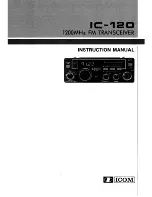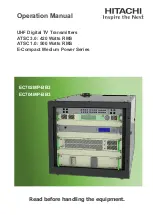
Section 8 – RCP Programming (Continued)
93
A menu will open listing the available project types. Select the one that matches the product you wish to program
(selecting a project type will display a picture of the product for verification). The
telePilot
transmitter is identified by the
number of buttons on the right hand side of the transmitter. A two speed transmitter will have 6 buttons, and a single speed
transmitter will have 7. Functions that relate to certain transmitter types will be identified in this manual by transmitter
type i.e.
(2 speed only)
.
Common settings.
The
tele
Pilot transmitter has four configurable “Banks” available. Each bank is a complete operational configuration
consisting of frequency, access code, and other transmitter parameters. These banks give the capability to operate up to
four different cranes using one transmitter, and they can be used as possible options for crane select.
These are settings that apply to all four banks of the transmitter.
Bank Password (Can be disabled).
The Bank Password prevents the active transmitter bank from being changed accidentally. The Bank Password is the same
for all Banks. Bank password protection is described in detail in
Section 4-5.
Additional
telePilot
Operational Features.
Please familiarize yourself with this section before programming.
If you choose not to use the default password, you
can create a new password by selecting the buttons to be used with the four pull down menus, “First press”, “Second Press”
etc. Be sure to write this password down in a safe place for future reference. The default password is 6, 5, 4, 3.
NOTE
ALWAYS REMEMBER TO STORE THE PASSWORD IN A SECURE LOCATION FOR ACCESS IF THE
PASSWORD IS LOST OR FORGOTTEN. ONCE THE TRANSMITTER IS PROGRAMMED THERE IS NO WAY TO
DEFEAT THE PASSWORD WITHOUT USING THE RCP SOFTWARE TO EITHER READ THE PASSWORD OUT
OR REPROGRAM A NEW ONE.
WARNING
THIS PASSWORD FUNCTION IS NOT TO BE USED AS A SECURITY DEVICE. THE PURPOSE OF THIS
FUNCTION IS TO PREVENT ACCIDENTAL BANK SWITCHING. THE BEST FORM OF SECURITY IS ALWAYS
TO LOCK UP THE TRANSMITTER WHEN NOT IN SERVICE. FAILURE TO FOLLOW THIS WARNING COULD
RESULT IN SERIOUS INJURY OR DEATH AND DAMAGE TO EQUIPMENT
.
















































